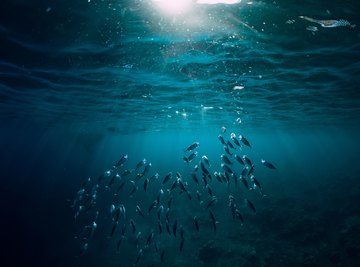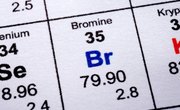
An ecosystem is an aggregate of all the biological and chemical properties characteristic to a particular ecological community. An aquatic ecosystem derives its identity from the interaction between its watery environment and the living organisms that inhabit it. The two types of aquatic ecosystems are freshwater and marine, and the main difference is the salinity concentration. However, these ecosystems have several characteristics in common.
Water
The most obvious link between marine and freshwater ecosystems is water, covering almost 75 percent of the earth's surface. Liquid water is the basic component of both freshwater and saltwater aquatic environments. Since water is transparent, aquatic phytoplankton can thrive because the sunlight can penetrate the uppermost regions. Also water is a polar molecule that lends itself to hydrogen bonding; in turn, this makes water a powerful solvent for the minerals and nutrients required for life.
Osmoregulation
The process of regulating the osmotic pressure on fluids inside an organism is essential to all freshwater and marine species. Osmoregulation helps them control the concentration of their body fluids. Some fish, such as salmon, demonstrate a remarkable variability in osmoregulating their homeostasis. This involves maintaining the correct concentration of solutes and water in their bodies.
Phytoplankton
Phytoplankton are algae that inhabit the upper layers of the oceans and freshwater bodies where the sun penetrates. Phytoplankton are the primary producers of the aquatic food chain, obtaining their energy through photosynthesis, and as a result, produce much of the oxygen in the earth's atmosphere. As the base of the aquatic food web, they provide an essential ecological function for all marine and freshwater aquatic life.
Environmental Problems
The most pervasive problem affecting both freshwater and marine ecosystems is pollution, coming in the form of the release of by-products of human activity such as sewage, farm waste, fertilizers and toxic or inert chemicals that can kill aquatic life. Eutrophication, or plant overgrowth, results from the discharge of these substances into the water. These materials all have high nitrogen and phosphorus contents that promote the exponential growth of both microscopic and macroscopic plants in the water. Eventually the plants die and stagnate the water. The decomposition process then reduces the dissolved oxygen in the water, making it impossible to support life.
References
Resources
About the Author
Diane Evans is a retired civil engineer who has worked as a freelance writer/illustrator since 1988. She writes for various online publications, and also authors nonfiction and fiction for children’s and adult publications. Her education includes a B.S. in biology and an M.S. in biochemistry from Vanderbilt University, as well as a Bachelor of Civil Engineering from the Georgia Institute of Technology.
